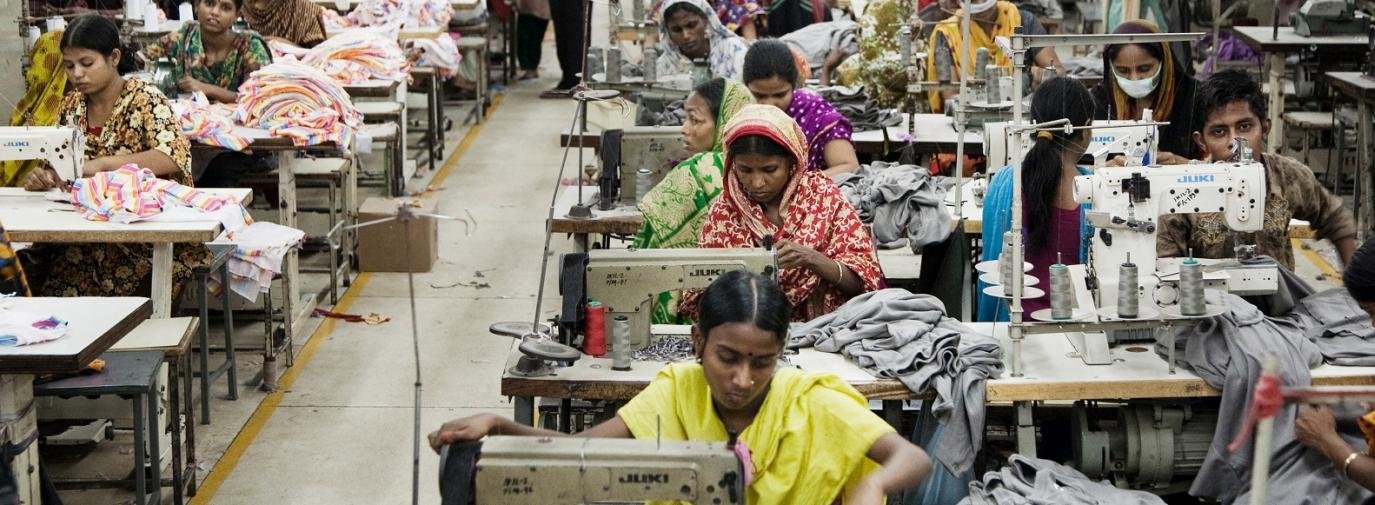Moving Fast: Fashion as a Driving Colonial Force
A young garment worker demonstrates against safety violations at a 2015 rally commemorating the deadly Rana Plaza collapse. Photo Credit: Solidarity Center.
We all know that fast fashion is criminal in more ways than one, and yet most of us are guilty of having a closet full of pieces that are made just as quickly as they go out of style.
How can you blame us? Especially when the driving argument is that corporations and sweatshops are culpable for shaping the culture of our relationship to clothing and that the everyday person has little to no control over these processes. Yet, that is not the complete truth, and we all kind of know it. Whether we want to admit it or not, there are plenty of options that exist, but we think about them only as much as we think about the illegal dumping of millions of tonnes of our throwaway clothes on the coasts of other countries. The real issue is that we have become deeply disconnected from the origins and outcomes of the things we buy, and have been indoctrinated into accepting this through global production systems of our capitalist economy. The oppression is so outsourced and obscured to the point that we can’t even recognize that we are the ones fueling it.
How did it all get here to begin with? In order to understand the trajectory of fast fashion we have to look at the deeper global economic and political processes that shape the means of production that we see today. Industrialization, factories, and the assembly line might appear to be the impetus for these processes — but they only intensified it. The cotton gin is an example of this; cotton production (and slavery) were already a staple part of industry in the U.S., but the invention of the cotton gin exponentially increased and prolonged it. The machine may have played a critical role, but the mechanism behind subjugating peoples for profit is a far more pervasive enemy.
Labor, production, and waste have all been disconnected from the consumer so that we can indulge in the pleasure of our products without the problematic realities of their existence, namely where they begin and how they end up. Looking deeper, you can see how the project of fast fashion represents the colonial processes of material and cultural exploitation. It is the divide and conquer model for marketing, and it affects producers and consumers to the same degree with opposite effects. The technologies used to advance market driven consumption, whether they be tools to harvest, manufacture, distribute, or even advertise fashion, can largely tie themselves to colonial and capitalistic practices.
The project of colonialism was mainly a market intervention over disparate peoples and lands, in order to favorably centralize economic power in the western world. The colonial power would control the production of raw materials in an area, seize them, manufacture them in their own countries, then sell the products with their own stamp that would render it more valuable (via establishing a false cultural superiority), while also using the colonized area as another market to sell their goods. In this vicious cycle, communities were frequently torn apart from the materials that once shaped their relationship to their land and culture — and were also made to feel less human and subservient to the larger machine of industry they were yoked into.
It is no coincidence that the home to the world’s largest luxury fashion houses are also the most prolific colonizers in history. As European powers manipulated the global market through the rampant spread colonialism, the cultural roots of fashion became as perverted as the trade routes carved out to create them. Such as the importation of textiles from colonized Indonesia to African communities, which would completely transform their wardrobe, curate their taste, and come to represent their culture. This market manipulation made the once self-reliant communities dependent on European trade across the continent, despite the fact that they had the raw material and labor to produce quality goods on their own. In many ways, not much has changed but our awareness and the scale of how manipulated our tastes and purchases are, and the number of key players in these global production systems (with China taking the lead).
Despite its temporality, fashion has long been valued beyond over human life. Take indigo for instance. At one point, the color used to dye fabrics was used as currency, where, “They were trading one length of cloth, in exchange for one human body." If you think that is a bizarre practice you may want to think twice about your blue jeans, which could have been produced by Chinese garment workers who get paid as little as 6 cents an hour for 20 hour shifts, with cotton probably sourced from farmers in India who have a suicide rate of over a quarter million due to faulty seeds their forced to farm by Monsanto. Whether by the force of chattel slavery, sweatshops, or political and economic oppression, the supply and demand chain of the objects we wear are heavy with the pains of its producers.
We’ve been tied up in these processes for hundreds of thousands of years — but the current rate of social and environmental detriment from textile production is destroying us. The best way to counter the global manifestation of industrialized fashion is to slow down its production and consumption. Learning more about what markets are available to us and reclaiming our agency as consumers would force manufacturing conglomerates to change their practices, or even better, become obsolete. We must buy things with more than just an aesthetic value, but also think critically about what the pieces we purchase represent in the longer trajectory of time — be that the past or the future. Try to think of the lifespan of your pieces differently and value the life that went in to creating them. Cherish quality over quantity (trust me, you can have both). Whether you choose to or not, your wardrobe tells a story — it is a collection that reflects your identity. We should all be searching for timelessness and mementos, pieces we believe in, and live by the histories we want to leave behind.





